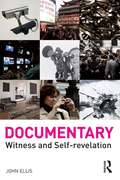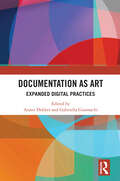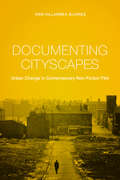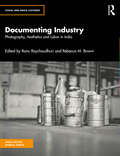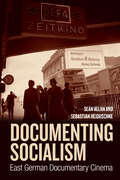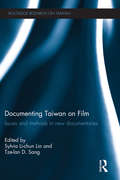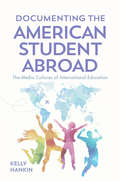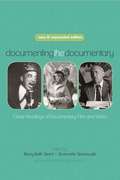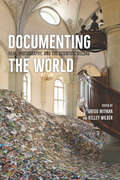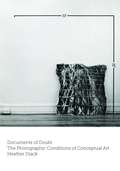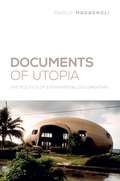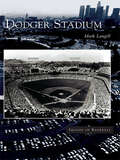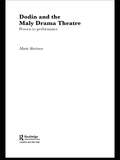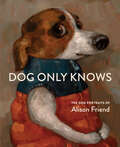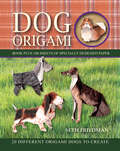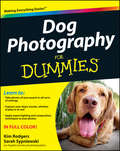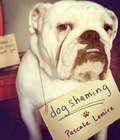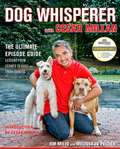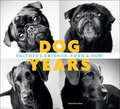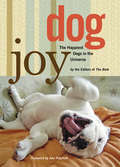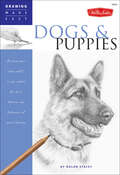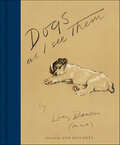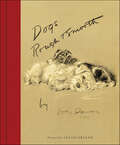- Table View
- List View
Documentary: Witness and Self-Revelation
by John EllisDigital technologies have transformed documentary for both filmmakers and audiences. Documentary: Witness and Self-Revelation takes an audience-centred approach to documentary, arguing that everyday experiences of what it feels like to film and to be filmed have developed a new sophistication and skepticism in today’s viewers. The book argues that documentary has developed a new third phase of its century long history: films now tend to document the encounters between filmers and the filmed. But what do we really know about those encounters? The author’s extensive experience of documentary production practice also enables him to examine technological changes in detail. Innovations in technology can seem to offer greater realism but can at the same time frustrate attempts to achieve it. John Ellis therefore proposes the idea of ‘Slow Film’ as an antidote to the problems of increasing speed brought about by easy digital editing. This book is ideal for students studying film, media studies and visual culture.
Documentation as Art: Expanded Digital Practices
by Gabriella Giannachi Annet DekkerDocumentation as Art presents documentation as an expanded practice that is radically changing the ways in which to look at, participate in, and generate art. Bringing together expertise from different disciplines, the book provides an in-depth investigation of the development of documentation as a set of production, circulation, and preservation strategies. Illustrating how these are often led by artists, audiences, and museums, the contributions offer new insights into digital art and its history, curation, and preservation, through documentation. Considering documentation as the main method of preserving these art forms, the book analyses how it can address the inherent challenges of capturing live events, visitor experiences, and evolving artworks. Showing how documentation itself can become (part of) an original artwork, the book discusses ways in which these expanded practices can impact the value and experience of the documented event or artwork, giving consideration to how this might affect the traditional authority of the museum as creator of documentation used for future reference, historical relevance, or cultural memory. Documentation as Art demonstrates how the curation and preservation of documentation and the introduction of audience-generated documentation are radically changing exhibition and visiting practices in which documentation is becoming a significant and emergent cultural form in its own right. The book will appeal to researchers and students engaged in the study of museums and curation, art and art history, performance, new media and digital art, library and information science, and conservation.
Documenting Cityscapes
by Iván Villarmea ÁlvarezFilm studies has traditionally addressed the presence of the city in film as an urban text inside a cinematic text, but this approach has recently evolved into the study of cinema as a technology of place. From this perspective, Documenting Cityscapes explores the way the city has been depicted by non-fiction filmmakers since the late 1970s, paying particular attention to three aesthetic tendencies: documentary landscaping, urban self-portraits and metafilmic strategies. Through formal analysis of fifteen works from six different countries, this volume investigates how the rise of subjectivity has helped to develop a kind of gaze that is closer to citizens than to those institutions and corporations responsible for recent major transformations. Thus, Documenting Cityscapes reveals the extent to which cinema has ultimately become an agent of urban change, where certain films not only challenge the most controversial policies of late-capitalism but also are able to produce spatiality themselves.
Documenting Cityscapes: Urban Change in Contemporary Non-Fiction Film (Nonfictions)
by Iván Villarmea ÁlvarezWhile film studies has traditionally treated the presence of the city in film as an urban text operating inside of a cinematic one, this approach has recently evolved into the study of cinema as a technology of place. From this perspective, Documenting Cityscapes explores the way the city has been depicted by nonfiction filmmakers since the late 1970s, paying particular attention to three aesthetic tendencies: documentary landscaping, urban self-portraits, and metafilmic strategies. Through the formal analysis of fifteen works from six different countries, this volume investigates how the rise of subjectivity has helped to develop a kind of gaze that is closer to citizens than to the institutions and corporations responsible for recent major transformations. Documenting Cityscapes therefore reveals the extent to which cinema has become an agent of urban change, in which certain films not only challenge the most controversial policies of late capitalism but also are able to produce spatiality themselves.
Documenting Industry: Photography, Aesthetics and Labor in India (Visual and Media Histories)
by Rebecca M. Brown Ranu RoychoudhuriWhether a smoky portrait of a coal mine or a sweeping shot of workers building an immense dam, photographs of established and emerging industries fundamentally shaped the visual culture and politics of South Asia in the decades after independence. This volume engages with the image of the laboring body against monumental machines, dams, and infrastructure and the ways in which photography engages with strands of modernist aesthetics to support new modes of seeing the changing industrial landscape and the human body.The multidisciplinary essays in the book embrace the porosity of “documentary” and “journalistic” photography and draw out questions of aesthetics in relation to both modernizing calls to industry and modernist framings of the visual in India. The book looks back at photographs from the twentieth and twenty-first centuries and critically considers post-World War II industry—with its imagery of factories belching pollutants into the air and the reality of massive displacements of workers due to epidemics, floods, and drought. It analyzes these images in relation to contemporaneous understandings of aesthetics and in dialogue with recent understandings of the global climate crisis. The volume probes the co-constitution of industry and photography in postcolonial India by looking at selected sites of industrial and artistic practices and their interwoven histories.Part of the Visual Media and Histories Series, this book will be of interest to students and researchers of the history of photography, visual media studies, Indian history, art history, cultural studies, and South Asian studies.
Documenting Socialism: East German Documentary Cinema
by Sebastian Heiduschke Seán AllanMore than 30 years after the collapse of the German Democratic Republic, its cinema continues to attract scholarly attention. Documenting Socialism moves beyond the traditionally analyzed feature film production and places East Germany’s documentary cinema at the center of history behind the Iron Curtain. Covering questions of gender, race and sexuality and the complexities of diversity under the political and cultural environments of socialism, the specialist contributions in this volume cohere into an introductory milestone on documentary film production in the GDR.
Documenting Taiwan on Film: Issues and Methods in New Documentaries (Routledge Research on Taiwan Series)
by Sylvia Li-chun Lin Tze-lan D. SangTo date, there is but a handful of articles on documentary films from Taiwan. This volume seeks to remedy the paucity in this area of research and conduct a systematic analysis of the genre. Each contributor to the volume investigates the various aspects of documentary by focusing on one or two specific films that document social, political and cultural changes in recent Taiwanese history. Since the lifting of martial law, documentary has witnessed a revival in Taiwan, with increasing numbers of young, independent filmmakers covering a wide range of subject matter, in contrast to fiction films, which have been in steady decline in their appeal to local, Taiwanese viewers. These documentaries capture images of Taiwan in its transformation from an agricultural island to a capitalist economy in the global market, as well as from an authoritarian system to democracy. What make these documentaries a unique subject of academic inquiry lies not only in their exploration of local Taiwanese issues but, more importantly, in the contribution they make to the field of non-fiction film studies. As the former third-world countries and Soviet bloc begin to re-examine their past and document social changes on film, the case of Taiwan will undoubtedly become a valuable source of comparison and inspiration. These Taiwanese documentaries introduce a new, Asian perspective to the wealth of Anglo-American scholarship with the potential to serve as exemplar for countries undergoing similar political and social transformations. Documenting Taiwan on Film is essential reading for all those interested in Taiwan Studies, film studies and Asian cinema.
Documenting the American Student Abroad: The Media Cultures of International Education
by Kelly Hankin1 in 10 undergraduates in the US will study abroad. Extolled by students as personally transformative and celebrated in academia for fostering cross-cultural understanding, study abroad is also promoted by the US government as a form of cultural diplomacy and a bridge to future participation in the global marketplace. In Documenting the American Student Abroad, Kelly Hankin explores the documentary media cultures that shape these beliefs, drawing our attention to the broad range of stakeholders and documentary modes involved in defining the core values and practices of study abroad. From study abroad video contests and an F.B.I. produced docudrama about student espionage to reality television inspired educational documentaries and docudramas about Amanda Knox, Hankin shows how the institutional values of “global citizenship,” “intercultural communication,” and “cultural immersion” emerge in contradictory ways through their representation. By bringing study abroad and media studies into conversation with one another, Documenting the American Student Abroad: The Media Cultures of International Education offers a much needed humanist contribution to the field of international education, as well as a unique approach to the growing scholarship on the intersection of media and institutions. As study abroad practitioners and students increase their engagement with moving images and digital environments, the insights of media scholars are essential for helping the field understand how the mediation of study abroad rhetoric shapes rather than reflects the field’s central institutional ideals.
Documenting the Documentary: Close Readings of Documentary Film and Video, New and Expanded Edition
by Barry Keith Grant Jeannette SloniowskiOriginally released in 1998, Documenting the Documentary responded to a scholarly landscape in which documentary film was largely understudied and undervalued aesthetically, and analyzed instead through issues of ethics, politics, and film technology. Editors Barry Keith Grant and Jeannette Sloniowski addressed this gap by presenting a useful survey of the artistic and persuasive aspects of documentary film from a range of critical viewpoints. This new edition of Documenting the Documentary adds five new essays on more recent films in addition to the text of the first edition. Thirty-one film and media scholars, many of them among the most important voices in the area of documentary film, cover the significant developments in the history of documentary filmmaking from Nanook of the North (1922), the first commercially released documentary feature, to contemporary independent film and video productions like Werner Herzog's Grizzly Man (2005) and the controversial Borat (2006). The works discussed also include representative examples of many important national and stylistic movements and various production contexts, from mainstream to avant-garde. In all, this volume offers a series of rich and revealing analyses of those "regimes of truth" that still fascinate filmgoers as much today as they did at the very beginnings of film history. As documentary film and visual media become increasingly important ways for audiences to process news and information, Documenting the Documentary continues to be a vital resource to understanding the genre. Students and teachers of film studies and fans of documentary film will appreciate this expanded classic volume.
Documenting the World: Film, Photography, and the Scientific Record
by Gregg Mitman Kelley WilderImagine the twentieth century without photography and film. Its history would be absent of images that define historical moments and generations: the death camps of Auschwitz, the assassination of John F. Kennedy, the Apollo lunar landing. It would be a history, in other words, of just artists' renderings and the spoken and written word. To inhabitants of the twenty-first century, deeply immersed in visual culture, such a history seems insubstantial, imprecise, and even, perhaps, unscientific. Documenting the World is about the material and social life of photographs and film made in the scientific quest to document the world. Drawing on scholars from the fields of art history, visual anthropology, and science and technology studies, the chapters in this book explore how this documentation--from the initial recording of images, to their acquisition and storage, to their circulation--has altered our lives, our ways of knowing, our social and economic relationships, and even our surroundings. Far beyond mere illustration, photography and film have become an integral, transformative part of the world they seek to show us.
Documents of Doubt: The Photographic Conditions of Conceptual Art
by Heather DiackA major reassessment of photography&’s pivotal role in 1960s conceptual artWhy do we continue to look to photographs for evidence despite our awareness of photography&’s potential for duplicity? Documents of Doubt critically reassesses the truth claims surrounding photographs by looking at how conceptual artists creatively undermined them. Studying the unique relationship between photography and conceptual art practices in the United States during the social and political instability of the late 1960s, Heather Diack offers vital new perspectives on our &“post-truth&” world and the importance of suspending easy conclusions in contemporary art.Considering the work of four leading conceptual artists of the 1960s and &’70s, Diack looks at photographs as documents of doubt, pushing the form beyond commonly assumed limits. Through in-depth and thorough reevaluations of early work by noted artists Mel Bochner, Bruce Nauman, Douglas Huebler, and John Baldessari, Diack advances the powerful thesis that photography provided a means of moving away from the object and toward performative effects, playing a crucial role in the development of conceptual art as a medium of doubt and contingency.Discussing how unexpected and contradictory meanings can exist in the guise of ordinary pictures, Documents of Doubt offers evocative and original ideas on truth&’s connection to photography in the United States during the late 1960s and how conceptual art from that period anticipated our current era of &“alternative facts&” in contemporary politics and culture.
Documents of Utopia
by Paolo MagagnoliThis timely volume discusses the experimental documentary projects of some of the most significant artists in today's global art world: Hito Steyerl, Joachim Koester, Tacita Dean, Matthew Buckingham, Zoe Leonard, Jean-Luc Moulène, Ilya & Emilia Kabakov, Jon Thomson & Alison Craighead, and Anri Sala. Their films, videos, and photographic series address the history of failed utopian experiments and counter-hegemonic social practices. This study illustrates the political significance of these artistic practices and offers a crucial contribution to the debate on the conditions of utopian thinking in late capitalist society, arguing that contemporary artists' interest in the past is the result of a shift within the temporal organization of the utopian imagination from its futuristic pole toward the pole of remembrance. The book therefore provides one of the first critical examinations of the recent turn towards documentary in the field of contemporary art.
Documents of Utopia: The Politics of Experimental Documentary (Nonfictions)
by Paolo MagagnoliThis timely volume discusses the experimental documentary projects of some of the most significant artists working in the world today: Hito Steyerl, Joachim Koester, Tacita Dean, Matthew Buckingham, Zoe Leonard, Jean-Luc Moulène, Ilya and Emilia Kabakov, Jon Thomson and Alison Craighead, and Anri Sala. Their films, videos, and photographic series address failed utopian experiments and counter-hegemonic social practices. This study illustrates the political significance of these artistic practices and critically contributes to the debate on the conditions of utopian thinking in late-capitalist society, arguing that contemporary artists' interest in the past is the result of a shift within the temporal organization of the utopian imagination from its futuristic pole toward remembrance. The book therefore provides one of the first critical examinations of the recent turn toward documentary in the field of contemporary art.
Dodger Stadium (Images of Baseball)
by Mark LangillSince 1962, the inspiring architecture and sweeping vistas of Dodger Stadium have inspired millions of Los Angeles Dodgers baseball fans. What team president Walter OMalley envisioned nearly half a century ago endures as one of professional baseballs most striking pieces of architecture, standing in the shadow of the dramatic San Gabriel Mountains. Dodger Stadium is also one of only two such parks built during the 20th century constructed entirely with private funds. Most people think of the stadium as a world-class baseball park, and Dodger Stadium has certainly earned such a reputation, hosting eight World Series, an All-Star contest, and hundreds of action-filled games through the years, during which the Dodgers won eight National League championships and four World Series. But the stadium has been much more than a sporting ground, hosting Olympic ceremonies and events, a papal visit from John Paul II in 1987, and world-renowned musical events, ranging from Elton John to KISS to The Three Tenors. Other events have included ski-jumping competitions, boxing, and a Harlem Globetrotters basketball exhibition. For four years in the 1960s the stadium was also used by the Los Angeles Angels baseball team.
Dodin and the Maly Drama Theatre: Process to Performance
by Maria ShevstovaIncluding a foreword by Simon Callow, a dedicated admirer of the Maly, Dodin and the Maly Drama Theatre provides both a valuable methodological model for actor training and a unique insight into the journeys taken from studio to stage. This is the first ever full-length study of internationally-acclaimed theatre company, the Maly Drama Theatre of St. Petersburg, and its director, Lev Dodin.Maria Shevtsova provides an illuminating insight into Dodin's directorial processes and the company's actor 4raining, devising and rehearsal methods, which she interweaves with detailed analysis of the Maly's main productions. Dodin and the Maly Drama Theatre: Process to Performance demonstrates how the impact of Dodin's work extends far beyond that of his native Russia, and gives the reader unparalleled access to the company's practice.
Dog Only Knows: The Dog Portraits of Alison Friend
by Alison FriendA must-have gift book for every dog lover from acclaimed artist Alison Friend, featuring over 125 irresistible portraits—each uniquely mischievous, funny, and full of personality. Meet Midge, who keeps her mind sharp with a Rubik&’s Cube. Alan, who looks like a million dollars in his new harness. Lola, whose motto is &“People to see, bums to sniff.&” Chupa Chops—how did he unwrap that lollipop? The oh-so-earnest Clive, who does everything—biscuit eating, squirrel chasing, ball fetching—with a single-minded focus. Irrepressible Debbie, who loves cocktail night, and Little Louis, a chain-smoking existentialist who can&’t stop chewing over the canine condition. Usually with an espresso. Welcome to Alison Friend&’s world of dogs, a singular and very special place created by an artist with a unique gift for depicting that ineffable thing we call &“character&”—dog characters, actually—using oil paint, empathy, techniques of the Old Masters, and an imagination like no other. With their big expressive eyes and Mona Lisa smiles, charming habits and childlike pleasures, the subjects of these portraits seem all too human yet fantastically doglike. Capturing exactly—as Little Louis would tell you—the canine condition, though you&’ve never seen it like this before.
Dog Origami: 20 Different Origami Dogs to Create (Origami Books)
by Seth FriedmanYou'll be begging for more of these puppies!Origami is a peaceful, harmonious art form that sharpens your problem-solving skills and allows time to relax. You can have a ball of tail-wagging fun, too, when you fold up these 10 popular types of dogs, including a Shih Tzu, Bulldog, Shetland Sheepdog, Schnauzer, Beagle, Great Dane, Siberian Husky, Chihuahua, Greyhound, and Basset Hound. Information on each breed accompanies step-by-step instructions in the 80-page project book. Detailed diagrams ensure you don't miss a crease or pleat, and specially designed folding papers make your finished models something to be proud of. Wag more, bark less with this entertaining kit!
Dog Photography For Dummies
by Kim Rodgers Sarah SypniewskiTips and tricks for capturing your canine's personality with every click of the camera Simply snapping a picture may not capture the playfulness or spontaneity of a dog. Knowing what kind of equipment, angle, and composition to use while photographing a dog can make all the difference in the character captured in the photo. Dog Photography For Dummies gives you practical and fun guidance for capturing your dog's personality and turning ordinary shots into priceless memories that will last a lifetime. Covering all the latest and greatest gadgets and accessories available to capture and alter photos of your favorite pooch, Dog Photography For Dummies offers techniques that amateurs and intermediates alike can use to improve their photography skills. This hands-on guide features great examples of dog portraiture, plus tons of ideas for fun new places to pose your furry friend, such as the beach, the park, the car, in the snow, and more. Detailed discussions of color versus black-and-white, indoors versus outdoors, composition, and capturing movement Advice on how to get a dog to sit still Considerations for photographing a shy dog who is scared of the camera Guidance on making the most of natural light Tips for photographing dogs with black (or dark) coats How to photograph people and dogs together Whether for decorating, memories, or holiday cards, Dog Photography For Dummies makes it easy to capture the best of your four-legged friend.
Dog Shaming
by Pascale LemireBased on the runaway web phenomenon (www.dogshaming.com), Dog Shaming features the most hilarious, most shameful, and never-before-seen doggie misdeeds. Our dogs are our best friends. They are always happy to see us. They comfort us in our times of need. They also eat our shoes, stain our carpets, and embarrass us in front of our guests. Dog owners everywhere have found their outlet in Dog Shaming, where they can confess their dogs' biggest (and often grossest!) sins, which turn out to be recognizably universal--complete with snapshots of ridiculously cute but shamed pups who don't seem capable of humping humans, pooping on pillows, or snagging steak straight from a grill.So share in the shaming and laugh through your frustration as Dog Shaming reminds us that unconditional love goes both ways.From the Trade Paperback edition.
Dog Whisperer with Cesar Millan: The Ultimate Episode Guide
by Cesar Millan Melissa Jo Peltier Jim MilioIf you have a dog, if you love Dog Whisperer with Cesar Millan, if you love compelling reality TV, you must have the companion guide to the phenomenally popular television show starring dog behavior expert Cesar Millan. Cesar Millan has become the household name in dog rehabilitation. His #1-ranked National Geographic television show Dog Whisperer with Cesar Millan has become appointment television for fans with dogs and often those without them, too. Millions of viewers tune in every week, host Cesar-watching parties at their homes, and marvel over last week's episode at their local dog parks. Now, following his bestselling books, Cesar's Way and Be the Pack Leader, this episode guide will help newcomers and fans alike relive every moment from the show's first three seasons and learn some crucial dog behavior secrets in the process. Dog Whisperer with Cesar Millan: The Ultimate Episode Guide features 150 compelling stories of the dogs Cesar has met and mastered -- from NuNu the demon Chihuahua to Wilshire the firehouse Dalmatian. Easy to use and packed with Cesar's trademark wisdom, Dog Whisperer with Cesar Millan features: organization by behavioral problem (i. e. , aggression, phobias, obsessions) notable quotes, advice, and tips from Cesar photos of Cesar, the dogs he has met, and the people whose lives he's changed production secrets from behind the scenes of the show updates on how the dogs and their owners are getting along today Readers will be fascinated to learn how Cesar diagnosed and treated each dog's problem behavior and how he coached the owner to rectify it. The book's accessible format also includes indexes organized by breed and dog name. Dog Whisperer with Cesar Millan is an essential addition to any dog lover's library.
Dog Years: Faithful Friends, Then & Now
by Amanda JonesThe photographer behind Unleashed combines man’s best friend with time in this touching portrait collection capturing dogs as puppies and as older dogs.Dog Years is a heartwarming look at the lives and stories of thirty dogs. By presenting portraits of each dog as a puppy and again as an older dog, photographer Amanda Jones reveals the unique spark of personality that lasts a lifetime. These beautiful images of breeds ranging from golden retrievers and Great Danes to pugs and French bulldogs are accompanied by reflections from loved ones on the lives they share with their furry companions. The result is a celebration of each dog and a tribute to the relationships we share with our four-legged friends.
DogJoy: The Happiest Dogs in the Universe
by Editors of Bark<p>There is no greater joy than seeing a beloved dog smile. <p>Whether they're greeting us at the door, romping with their pals, or celebrating a birthday, their happiness is completely infectious. Do dogs really smile? <p>We set out to prove this idea after a reader of The Bark sent in a photo of her grinning dog, with a suggestion for a contest ... and, the Smiling Dog contest was born. <p>So for the past eight years, enthusiastic dog lovers everywhere have been sending in photographs of their smiling pups. DogJoy assembles the best of the pack—presenting proof positive that dogs not only smile, but also laugh, grin, snicker and even share jokes. <p>Highlighted by personal stories and peppered with charming observations, dog lovers everywhere will adore this wonderful collection.
Dogs & Puppies: Discover Your Inner Artist As You Explore The Basic Theories And Techniques Of Pencil Drawing (Drawing Made Easy)
by Nolon StaceyAn easy-to-follow guide to drawing canines, from sketching bodies, faces and hair to creating animal portraits of a favorite pet.Many aspiring artists want to draw a portrait of their best friend—especially where their pal has four paws and fur! This newest addition to the Drawing Made Easy series pairs our best-selling medium with the wildly popular subject of dogs and puppies. Unlike similar titles on the market, this book doesn’t simply provide a collection of dogs for artists to re-create exactly. Instead, the book focuses on techniques specific to drawing accurate depictions of dogs and puppies—from creating a variety of fur types and features to achieving accurate proportions—so that artists can use the knowledge to render their own canine portraits. The book also includes a series of easy-to-follow, step-by-step projects showcasing a range of dog breeds, poses and props. This allows artists to practice their developing skills, guiding them from simple sketches through the study of various techniques to polished renderings.
Dogs As I See Them
by Lucy DawsonA BELOVED CLASSIC FOR DOG LOVERS OF ALL AGESWith a new foreword by Ann PatchettIn the 1930s, Lucy Dawson’s friendly, sympathetic portraits of dogs were so popular with readers of American and British magazines that she agreed to gather them together in a book, Dogs As I See Them.Now available once again after being out of print for decades, and a complete replication the original 1936 edition, Dogs As I See Them includes all of Dawson’s irresistible graphite and pastel drawings and handwritten notes. Along with her illustrations are her own amusing stories about the conduct of each of her subjects as they posed for her. Her charming reminiscences interpret the character and mood of each dog, and make us friends at once with each and every one in this gallery of endearing portraits. Dogs As I See Them is a remarkable collection dog lovers of all generations will take to their hearts.
Dogs Rough and Smooth: Foreword By Susan Orlean
by Lucy DawsonForeword by Susan OrleanA charming facsimile edition of celebrated British illustrator Lucy Dawson’s 1937 classic collection of highly detailed and loveable drawings of dogs, complete with a cloth spine and ribbon marker—the companion volume to the acclaimed Dogs As I See Them.Lucy Dawson, also known as "Mac," was a preeminent British illustrator in the 1930s and 1940s revered for her paintings and etchings of dogs, from sporting and non-sporting breeds to hounds and herders. Though she worked in numerous mediums—pencil, pen, ink, and oil—her pastels set her work apart. Noted for her commercial dog postcards and her delightful "Tailwagger" series, she also created a "Puppies" series of 40 cigarette cards during World War II—produced in a limited quantity due to wartime restrictions on paper—which have become a rare collector’s item today. One of her most famous works is her portrait of "Dookie," the British Royal Family’s favorite Corgie, which was later reproduced as a Royal Family Christmas card.Dawson also published several books, including the beloved Dogs As I See Them, and its follow-up, Dogs Rough and Smooth. Now, Dogs Rough and Smooth is available in a lovely facsimile edition for a new generation discovering her superb craftsmanship. Printed on an uncoated stock that simulates the look and feel of a sketchbook, this delightful volume is filled with her beautiful, endearing drawings of a range of breeds. The illustrations are accompanied by notes in Dawson’s own handwriting as well as a short anecdotal text that provides amusing insight into the personalities of her canine models and the experience of drawing each.A stunning reproduction of this classic work filled with full-color and black-and-white complete drawings and sketches, Dogs Rough and Smooth features a foreword by acclaimed writer Susan Orlean, and is packaged in a three-piece case with a beautiful cloth spine and long ribbon bookmark. Dogs Rough and Smooth is sure to be a collector's item treasured by dog lovers of all ages and art connoisseurs for years to come.
